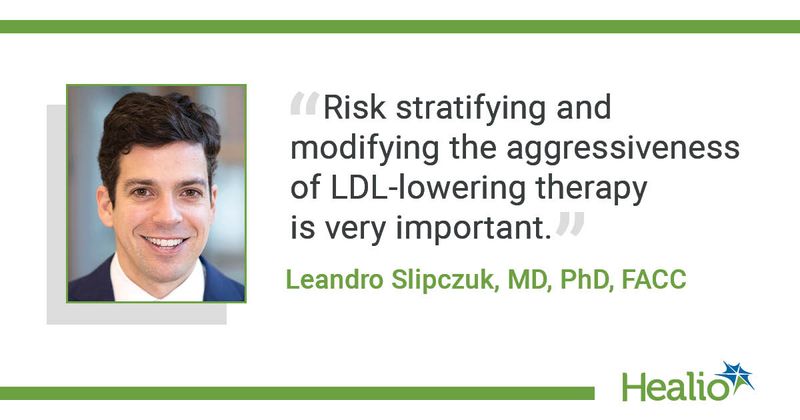December 05, 2023
3 min read
Key takeaways:
- Higher LDL level is tied to increased mortality risk, yet one in four patients with severe hypercholesterolemia is not prescribed statin therapy.
- Multiple factors influence mortality risk in this cohort.
Electronic records data show race, sex, age and comorbidities influence mortality risk for adults with severe hypercholesterolemia and that one in four of these high-risk patients is not prescribed statin therapy.
“We must be aware that an LDL of more than 190 mg/dL is high risk and these patients must be treated,” Leandro Slipczuk, MD, PhD, FACC, section head of clinical cardiology, director of advanced cardiac imaging and director of the Cardiovascular Atherosclerosis and Lipid Disorder Center at Montefiore Medical Center, New York, told Healio. “We should offer high-intensity statins for these patients and we should also assess the comorbidities and treat those. There are multiple tools to use for restratification; comorbidities is one and coronary artery calcium score is another. Risk stratifying and modifying the aggressiveness of LDL-lowering therapy is very important.”

Data from diverse cohort
In a retrospective study using electronic health records data, Slipczuk and colleagues analyzed data from 18,740 adults with at least one LDL measurement of 190 mg/dL or higher who sought care at Montefiore from 2010 to 2020. The mean age of patients was 54 years; 38.1% were women; 37% were Black; 30% were Hispanic and 12% were white.
“A lot of the data on familial hypercholesterolemia in particular has been conducted with mostly white cohorts,” Slipczuk said during an interview. “We cannot just extrapolate that data to other ethnicities and races. At Montefiore, we have a diverse patient population that better represents the country at large, making this a good sample to study this issue.”
The primary endpoint was all-cause mortality, stratified by age, sex and race. Researchers also stratified findings by primary and secondary prevention populations. The findings were published in Circulation.
During 9 years of follow-up (median follow-up, 5.2 years), 8% of patients died. As a continuous variable, higher LDL was associated with increased risk for mortality.
In adjusted models, higher LDL and triglyceride levels were associated with increased 9-year mortality risk, with adjusted HRs of 1.08 (95% CI, 1.05-1.11) and 1.04 (95% CI, 1.02-1.06) per 20-mg/dL increase, respectively.
Clinical factors associated with higher mortality included male sex (aHR = 1.31; 95% CI, 1.08-1.58), older age (aHR = 1.19 per 5-year increase; 95% CI, 1.15-1.23), hypertension (aHR = 2.01; 95% CI, 1.57-2.57), chronic kidney disease (aHR = 1.68; 95% CI, 1.36-2.09), diabetes (aHR = 1.79; 95% CI, 1.5-2.15), HF (aHR = 1.51; 95% CI, 1.16-1.95), MI (aHR = 1.41; 95% CI, 1.05-1.9) and BMI of 20 kg/m2 or less (aHR = 3.36; 95% CI, 2.29-4.93).
Black, Asian and white patients in the cohort had a similar all-cause mortality risk; however, researchers observed a lower risk for Hispanic patients (aHR = 0.73; 95% CI, 0.55-0.96).
“We observed something very interesting, and that was that our Hispanic patients had a lower mortality risk compared with other races,” Slipczuk told Healio. “This is a pattern known as the Hispanic paradox; despite similar risk factors as other races, Hispanic patients have lower mortality. There are many explanations for this; they may see their clinicians more often or have better medication adherence.”
Role for statin therapy
In the primary prevention group, HDL of 40 mg/dL or lower was independently associated with higher mortality (aHR = 1.49; 95% CI, 1.06-2.09).
“There has been some controversy regarding very high HDL — is it protective or not? This has not really been studied among patients with an LDL of 190 mg/dL or higher,” Slipczuk told Healio. “We found that very high levels of HDL actually were associated in univariate analysis with higher mortality. This also was seen with BMI, where low and very high levels were associated with higher mortality, but lower mortality was seen in patients mildly overweight or obese.”
Researchers also observed a significant survival benefit with lipid-lowering therapy (aHR = 0.57; 95% CI, 0.42-0.77). Temporal trend analyses showed a reduction in statin use over time (P < .001). In the most recent period, 2019-2020, 56% of primary prevention patients and 85% of secondary prevention patients were prescribed statin therapy.
“We saw a significant proportion of patients that were not on statin therapy — about 25% — and this was worse among primary prevention patients,” Slipczuk said. “This is not a unique issue with our population; it is happening everywhere. There is a lack of realization of the high risk these patients have. Even with heterogeneity of risk, these are all high-risk patients and they should all be on statin therapy. We know the benefits of statin therapy and we show them here with lower mortality.”
Slipczuk also noted that most patients experienced a rise in LDL with subsequent measurements.
“We have a lot of new therapies, including ezetimibe and PCSK9 inhibitors, that are underused for these patients,” Slipczuk told Healio. “The challenge and the next steps for us is to dig into these different patterns we identified to better understand them. We cannot just conduct randomized controlled trials. We need these real-world data to see what therapies our patients are using.”
For more information:
Leandro Slipczuk, MD, PhD, FACC, can be reached at lslipczukb@montefiore.org; X (Twitter): @cardiomdphd.
Sources/Disclosures
Collapse
Disclosures:
Slipczuk reports receiving consultant fees from Amgen and Philips, advisory board fees from Bristol Myers Squibb and institutional grant support from Amgen and Philips. Please see the study for all other authors’ relevant financial disclosures.





